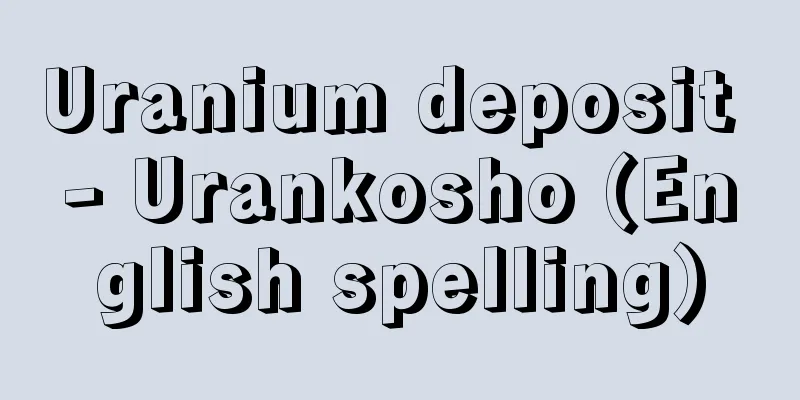Uranium deposit - Urankosho (English spelling)

|
A deposit that produces uranium minerals. Because uranium dissolves in water and is mobile in an oxidizing environment, the origin of the deposit and the occurrence of the ore vary widely. Uranium deposits are broadly classified into three types based on their form and origin. (1) Deposits related to igneous activity: deposits associated with volcanic rocks, pegmatites, carbonatites, hydrothermal vein deposits, etc. This includes the copper, uranium, and gold deposits in Australia. (2) Sedimentary deposits: These include conglomerate-type deposits, which were formed during the Proterozoic era when oxygen concentrations were low and uranium minerals did not dissolve in water but instead became concentrated physically due to differences in specific gravity; phosphorite deposits, in which uranium is contained in phosphorus minerals; and chemically concentrated deposits, such as black shale, which was formed when uranium in seawater was adsorbed by carbonaceous material and deposited. (3) Deposits formed when uranium dissolved in surface water or groundwater and migrated was reprecipitated. These include sandstone-type deposits found in ancient continental strata in the United States, Niger, Central Asia, etc., unconformity-type deposits accompanied by hydrothermal alteration near the Proterozoic unconformity surfaces in Canada and Australia, and calcrete-type deposits in which uranium is concentrated in calcareous rocks (calcrete) formed on the surface of semi-arid regions. There are many types of uranium minerals, but the important ones are uraninite, pitchblende, autunite, carnotite, and coffinite. The main deposits in operation as of 2003 include unconformity deposits in Canada and Australia, which have many large, high-grade deposits, sandstone deposits in Uzbekistan and other countries where uranium is extracted by injecting a solvent without mining, and conglomerate deposits in Australia and South Africa, where uranium is recovered as a by-product of copper mines. Japan also has sandstone deposits such as the Ningyotoge deposit on the border between Tottori and Okayama prefectures, and the Tono Mine in the Tono district of Gifu prefecture. [Mutsumi Mogi] [References] | | | | | | | | | | |Source: Shogakukan Encyclopedia Nipponica About Encyclopedia Nipponica Information | Legend |
|
ウラン鉱物を産する鉱床。ウランは酸化環境で水に溶けて移動しやすいため、鉱床の成因や鉱石の産状は変化に富んでいる。 ウラン鉱床は形態や成因から次の三つに大別される。 (1)火成活動にかかわる鉱床 火山岩、ペグマタイト、カーボナタイトに伴う鉱床や熱水鉱脈鉱床など。オーストラリアの銅・ウラン・金の複合鉱床もこれに含まれる。 (2)堆積(たいせき)性鉱床 酸素濃度が低い原生代にウラン鉱物が水に溶けずに比重差で物理的に濃集した礫岩(れきがん)型鉱床、燐(りん)鉱物にウランが含まれる燐灰土鉱床のほか、炭質物に海水中のウランが吸着されて堆積した黒色頁岩(けつがん)などの化学的に濃集した鉱床とがある。 (3)地表水や地下水に溶解して移動したウランが再沈殿した鉱床 アメリカ、ニジェール、中央アジアなどの古代陸成層に胚胎(はいたい)する砂岩型鉱床、カナダやオーストラリアの原生代の不整合面近くで熱水変質を伴う不整合型鉱床、半乾燥地域の地表で形成された石灰質岩(カルクリートcalcrete)にウランが濃集したカルクリート型鉱床など。 ウラン鉱物の種類は多いが、重要な鉱物は閃(せん)ウラン鉱、ピッチブレンド、燐灰ウラン鉱、カルノー石、コフィン石coffiniteなどである。 2003年時点で稼行されているおもな鉱床は、大規模高品位鉱床が多いカナダやオーストラリアの不整合型鉱床、採掘せずに溶媒を注入してウランを抽出しているウズベキスタンなどの砂岩型鉱床、銅鉱山の副産物としてウランを回収しているオーストラリアおよび南アフリカの礫岩型鉱床などがある。日本には鳥取・岡山県境の人形峠鉱床や、岐阜県東濃(とうのう)地区の東濃鉱山などの砂岩型鉱床がある。 [茂木 睦] [参照項目] | | | | | | | | | | |出典 小学館 日本大百科全書(ニッポニカ)日本大百科全書(ニッポニカ)について 情報 | 凡例 |
Recommend
fauxbourdon
… The height of vocal polyphony was during the Re...
Jewish philosophy
A general term for philosophical activities carrie...
Custard sauce
A sauce for Western confectionery made by adding e...
Pale
〘Emote〙 (pale) Meaning pale, thin, faded, pale, et...
One tune, one pipe - Iccho Ikkan
A Nohgaku ensemble. A specific part of a Noh play ...
Gai Qi (English spelling)
[Born] Qianlong 39 (1774) [Deceased] Doko 8(1828)/...
Iris japonica - Iris
...In the ninth chapter of the Tales of Ise, the ...
Jacket - Uwagi
〘noun〙① The outermost garment when wearing multipl...
Gold and silverware
It can refer to any vessel made of gold or silver ...
Countermeasures - Taisaku
〘noun〙① A method of examination for promotion to g...
wave packet
…As a result, when viewed as a whole, the amplitu...
Marco Polo Bridge Incident
This incident, which began on the night of July 7,...
Tsujibanashi - Stories about the streets
Rakugo was performed in the open air during the Ed...
American Federation of Teachers Unions - American Federation of Teachers Unions
In France, secondary teachers (1897) and primary ...
Toki Yoritomo - Time・Yoritoo
Year of death: Kōei 1/Kōkoku 3.12.1 (1342.12.29) Y...









